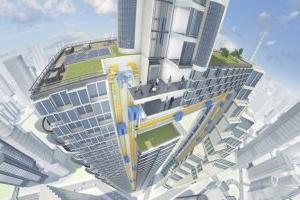Will Ropeless Elevators Change Building Design?
By TH!NK by IBI
Date
October 18, 2017德国最近开放了该国最高的观景台, 从230米高处360度俯瞰黑森林. But the significance of this new tower is far greater than just it’s view; the Rottweil Test Tower is a project by ThyssenKrupp to revolutionize the elevator, 这是一项从1854年的最初设计到现在还没有彻底改变的发明. 这种新型无绳电梯会改变未来的建筑设计吗?
蒂森克虏伯的工程师们为这种新型电梯命名 MULTI,描述了这项新技术所固有的多种可能性. Archinect detailed the project back in 2014, 描述系统的工作方式:“被认为是世界上第一个无缆电梯, MULTI包括一个多级制动系统和多个可集成在同一电梯井内的自行式轿厢. Operating on a circular system, 电梯将能够以5米/秒的速度在一个环形中垂直和水平移动, 由类似的新型直线电机技术提供动力 Transrapid magnetic-levitation train.” This new design can move more people, in more directions, in less time, 以各种可以想象的方式提高传统电梯的效率. 多部电梯将在同一座舱内运行,并能够在建筑物中所有相互连接的竖井之间自由移动. (观看上面嵌入的视频,了解这项技术的实际应用!)

Image Credit: ThyssenKrupp
这种新的电梯设计对未来的建筑意味着什么? 首先,它可以显著减小电梯核心的尺寸. 蒂森克虏伯估计,可用的建筑面积可以 increase by 25% 在高层建筑中采用这种新设计而不是传统的电梯. This is significant, especially with the increasing number of people living and working in cities, and the increasing construction of exceptionally tall buildings. The rope-less elevator is also significantly more energy efficient 比传统电梯,减少碳排放.
第一个客户已经签约,并计划安装在OVG房地产公司位于柏林的新东区大厦. How will this new technology work in real projects; will it be successful? Beyond more efficient high-rises, 还有哪些项目可以从这项创新中看到重大变化呢? How would it change circulation systems in metro stations and transit hubs? 它如何提高病人在医院的旅行效率? 这项新技术的革命性可能性看起来很光明.
Photo by Scott Szarapka on Unsplash







